| |
The cherry trees have already started blooming in the southern parts of Honshu. Here in Kitakami, the cherry blossoms are still a few weeks off, but their advance team has arrived. Plum blossoms started appearing last week, despite three days of snow. 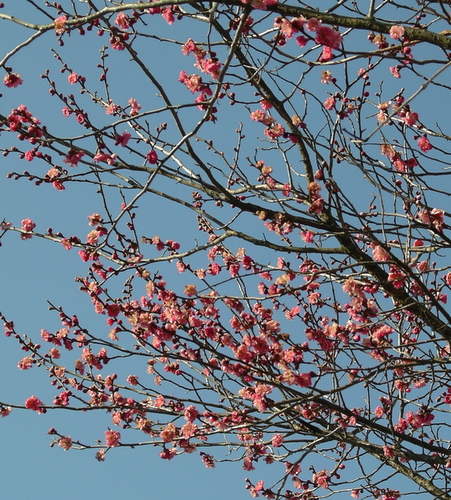
Tax time in Japan doesn't seem to evoke the same image of oppressive bureaucracy that it does in the U.S. I wonder if it's because the forms are simple and colorful? 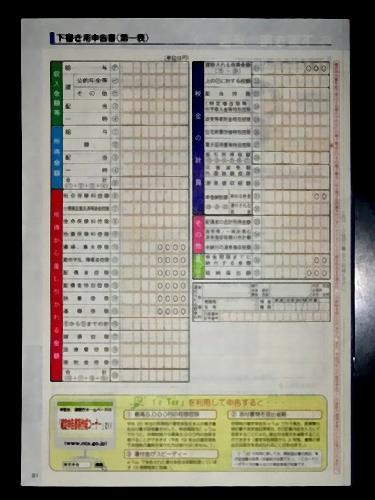 Or it may be because the instruction booklet includes a cute cartoon lady to guide you through the process. 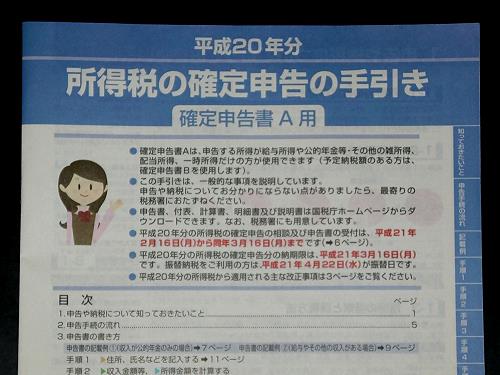 Actually, it's probably because the tax system itself is fairly straightforward. In fact, it's so simple that most people don't even have to file. Instead, employers just withhold the correct amount. But what about deductions, you ask? You tell your employer about them in December, and they make an adjustment on your last paycheck.
On Sunday, we went to Geto Ski Area, where the unusually clear skies afforded long range views in all directions. The summit is usually shrouded in fog, so it seemed like a special treat. To the east, we could see Mt. Hayachine, about 65 kilometers away in the central mountains of Iwate.  To the west, we could see Mt. Chokai, straddling the border between Akita and Yamagata, near the Sea of Japan, a little over 70 kilometers away.  And to the north, Mt. Iwate was barely visible, also about 70 kilometers distant. (We posted a closer view of Mt. Iwate last year.)  Finally, here's a map showing these mountains and Geto in relation to Kitakami and the east and west coasts of Japan. 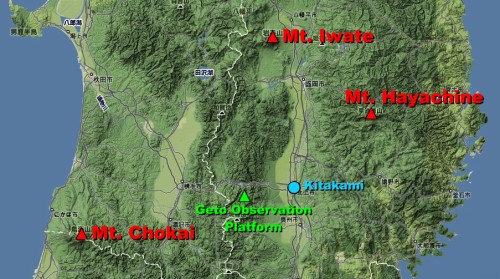
March 3 is about more than just good ear health. It's also the day of Hina Matsuri, or Girls' Day. Families with daughters celebrate the day to ensure their future happiness. The most recognizable feature of the celebration is an elaborate display of dolls ( hina ningyo). 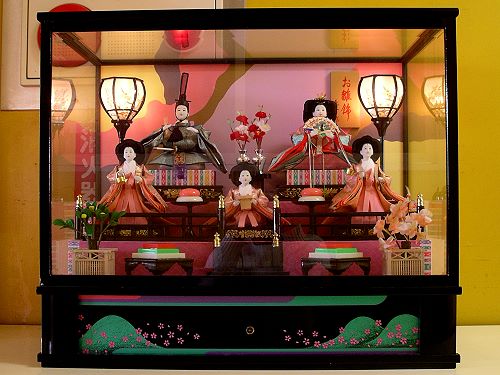 The dolls represent the emperor, empress, and members of their court. I believe the flowers are peach blossoms, which represent the traits of composure and tranquility.
March 3 is National Ear Health Day. Why? Because some countries don't mind enshrining puns in official proclamations. "Ear" is mimi, and "three" is mi, so 3/3 is "ear". It's a day to pay careful attention to ear health, and how better to do that than with a licensed Toy Story ear-shovel ( mimi-kaki) to clean the wax out? I was raised to "never put anything smaller than your elbow in your ear," but in Japan, ear-shovels are popular souvenir items. This one was a gift from one of my students who went to Tokyo Disneyland, and the alien is actually a bobble-head toy. 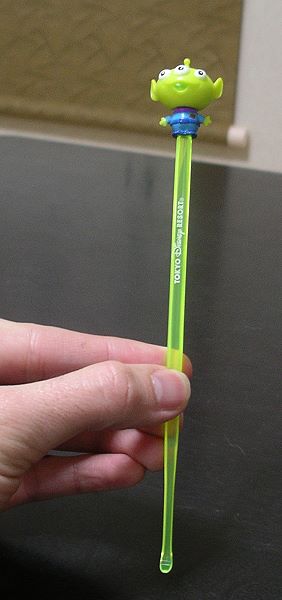
 A heavy overnight snow made the tetrapods in the Waga River near Kunenbashi look like pairs of seaweed-wrapped rice balls.
Thursday, February 12, 2009, 1:46 AM GeneralPosted by stefanie Due to an upcoming koto performance, I'm in the market for a kimono. They're beautiful, so I'm excited about the chance to wear one. There's a snag involved in buying one, though: new kimono are prohibitively expensive. A new kimono, obi (belt), and all of the various accoutrements can start at $3,000. If you can find one to your liking, a used kimono is a fraction of the cost. With this in mind, on Sunday we visited a local secondhand store known to sell used kimono. The shop had one whole corner dedicated to kimono and kimono accessories. We got down to business, searching through shelves of kimono to find ones that might work. Because of my Western build, few had any chance of fitting, and we were able to quickly whittle those few down to one: a dark red kimono with simple prints of pastel birds around the hem and on the sleeves. It seemed to fit, but because we really didn't know what we were doing and knew we'd also need to choose an obi, Matthew called a local friend to come help us out. While we were waiting, a stranger who had been watching us commented on the kimono. She started wrapping and folding it as if we were actually putting it on. Our friend showed up a few minutes later, and the two of them started talking to each other about the fit. I soon filled the role of a tall, curiously-shaped mannequin, with nothing to do other than listen to the " Theme from Shaft" over the PA system and shoot quizzical looks over their heads at Matthew as the women consulted in rapid-fire Japanese. They apparently decided that it would work, because they then moved on to choosing an obi for me. We joined them in sorting through the large selection of obi. Serendipity was on our side, and we found the perfect match in a pale, silvery mocha obi woven with a cherry blossom pattern. We agreed that we'd chosen well and sealed the deal. I still have to get some accessories to complete the look, but I'm pleased with the kimono and grateful for the generous guidance of people who know what they're doing.
Amazake is sweet, non-alcoholic, fermented rice. It's served in winter as a traditional hot drink. Nowadays, it's usually made by dissolving kasu — rice pulp filtered out during sake production — in hot water. But "real" amazake is not a by-product of sake production, it's its own fermented product. Real amazake is less widely available than kasu in stores, but in my opinion, it's a vastly superior product. Although only a few grocery stores seem to have real amazake, many offer packages of moldy rice. Covered with the koji mold needed to make amazake (or sake, for that matter), it's used as a "starter" for making real amazake at home. So, here's a close-up of the moldy rice we bought last week. 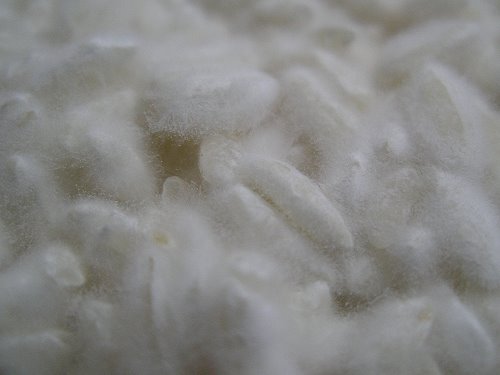 Making the amazake is fairly easy, but takes about 6 or 7 hours. In the end, it was worth it: some of the best amazake we've had!
[ 3 comments ] permalink
At our main grocery store, there are often vendors or special sales displays near the front of the store. Around the end of the year, for example, you'll see guys selling calendars and small statues of the next year's animal. Other times, there might be housewares or boxed gift sets of things like instant coffee or soy sauce. It's always new stuff, too, not like a flea market in the store. Not today. Today, a large banner stood in the center of the display announcing the nature of the items for sale: JR Wasuremono. Literally "JR Forgotten Things," they were from Japan Rail's collection of belongings left behind on trains. It's an unusual, if very sensible, solution to the problem created by collecting lost items ¡½ by selling them, JR makes money and gets them off of their hands. Perhaps it's an idea to take back to Washington and pitch to Metro.
Tuesday, January 20, 2009, 12:22 AM GeneralPosted by matthew We're outsiders here, there's no getting around that. The word for foreigner — gaijin — literally means "outside person". Even people who have obtained Japanese citizenship find that they can't be fully accepted. On the other hand, it's possible to be a part of the community, even if you aren't fully accepted. In that spirit, we eagerly participate in community activities from undoukai to yakudoshi. We always check the kairan-ban (traveling bulletin board) for new events, and ask questions when we need to. After we'd been here a year and a half, one day our neighborhood leader approached me at the recycling collection point. Surrounded by stacks of newspaper and bags of plastic, he produced the neighborhood's address book. He explained that we weren't in it because we were foreigners, but he'd been thinking we should be in it. It meant joining the neighborhood association, which is 300 yen a month. I politely said yes, then went home feeling like we'd been accepted to some extent. It was a small gesture (and it would cost us money), but we were now officially part of the community. A few days later someone dropped by to collect our membership fee and recorded our payment under our names, newly written in the book. Then, about two weeks later, someone else came by and left us the address book and the kairan-ban, declaring that it was our "duty month". "Our what?" Each household is responsible for distributing neighborhood information and collecting association dues for a month. "Oh." So it wasn't just a small fee and our names in a book. We were no longer guests in our community, and we were expected to help out. With no idea what to do, we imposed on our most helpful neighbor to explain things to us, then got to work — hearts lightened with the knowledge that, if only a little bit, we were being accepted.
Back Next
|
|










 Calendar
Calendar




